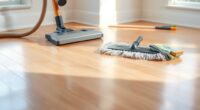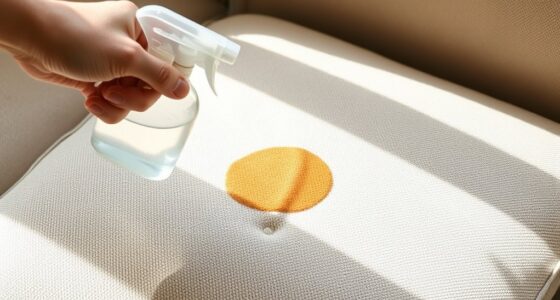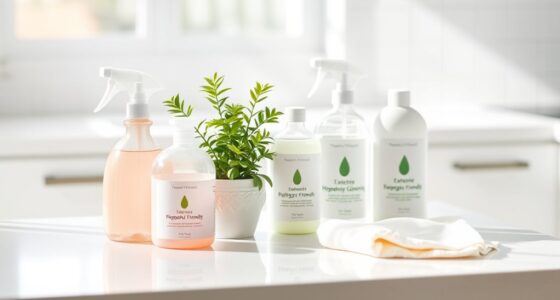To keep your upholstery looking fresh, quickly blot spills with a clean, dry cloth—avoid rubbing to prevent spreading stains. Treat water-based stains with a mild dish soap solution and oily stains with a vinegar mix, always testing first. Regular fabric protection sprays help prevent deep stains, while prompt action and proper cleaning techniques extend your furniture’s life. If you follow these spot-cleaning basics, you’ll maintain your upholstery beautifully—more tips lie ahead to help you master maintenance.
Key Takeaways
- Blot spills immediately with a clean, dry cloth to prevent stains from setting.
- Use a mild dish soap and cool water solution for water-based stains, dabbing from outside inward.
- For oily stains, apply a vinegar-water mixture and avoid rubbing to prevent fiber damage.
- Consider commercial upholstery cleaners for persistent or stubborn stains, following product instructions carefully.
- Regularly reapply fabric protector spray every six months to create a stain-resistant barrier and prolong furniture lifespan.

Keeping your upholstery looking its best requires regular care and attention. One of the most effective ways to maintain its appearance is by understanding the basics of spot-cleaning. Whether it’s a accidental spill or a stubborn stain, acting quickly can make all the difference in preserving your furniture’s fabric. To start, implementing fabric protection measures can help prevent stains from setting in. Applying a fabric protector spray creates a barrier that repels liquids and dirt, giving you extra time to address spills before they become permanent marks. Regularly reapplying this protection—at least every six months—can considerably extend your upholstery’s lifespan and keep it looking fresh.
Regular fabric protection helps keep your upholstery looking new longer.
When accidents happen, it’s essential to know the right stain removal techniques. The first step is always to blot—never rub—the affected area with a clean, dry cloth or paper towel to soak up as much of the spill as possible. Rubbing can push the substance deeper into the fibers, making it harder to remove. Once you’ve blotted away excess liquid, determine the type of stain and the fabric’s cleaning instructions. For water-based stains like coffee or juice, a mild solution of dish soap and cool water often does the trick. Dip a clean cloth into the solution, wring it out, and gently dab the stain, working from the outside inward to avoid spreading it. Follow up with a damp cloth to remove any soap residue, then blot dry with a towel.
For more stubborn or oily stains, you might need specialized stain removal techniques. A mixture of white vinegar and water can help dissolve grease and grime. Always test any cleaning solution on a hidden area first to prevent discoloration. If the stain persists, consider using a commercial upholstery cleaner formulated for your fabric type. Remember, patience is key—avoid applying too much pressure or scrubbing aggressively, as this can damage delicate fibers. After cleaning, allow the fabric to air dry completely, and avoid sitting on the furniture until it’s fully dry to prevent new stains from forming.
Consistent maintenance combined with prompt action can keep your upholstery looking its best. Regularly inspecting and treating your furniture with fabric protection and stain removal techniques ensures it remains inviting and beautiful for years to come. By understanding these simple, effective strategies, you’ll be better equipped to handle spills and stains quickly, minimizing damage and prolonging the life of your upholstery.
Frequently Asked Questions
How Often Should I Professionally Clean My Upholstery?
You should professionally clean your upholstery every 12 to 18 months, depending on fabric durability and cleaning frequency. If you have pets, children, or high-traffic areas, consider more frequent cleanings to keep your furniture looking fresh and extend its lifespan. Regular professional cleanings help remove deep-seated dirt and stains, maintaining the fabric’s quality and appearance. Be mindful of your fabric type to choose the right cleaning schedule.
Are DIY Spot-Cleaning Methods Safe for All Fabric Types?
Think of your fabric as a delicate garden; not all plants thrive with the same care. DIY spot-cleaning methods aren’t safe for all fabric types—some materials, like silk or velvet, need gentle, professional handling. Always check fabric compatibility and test cleaning solutions on a hidden area first. Using the wrong cleaning method can harm your upholstery, so when in doubt, consult a professional to guarantee safety and longevity.
Can I Use Bleach on Stained Upholstery?
You shouldn’t use bleach on stained upholstery because bleach safety isn’t compatible with most fabrics. Bleach can cause discoloration, weaken fibers, and ruin your furniture. Always check the fabric compatibility before trying any cleaning method. Instead, opt for gentle, fabric-safe stain removers or consult the manufacturer’s cleaning instructions. Protect your upholstery by avoiding harsh chemicals like bleach, ensuring your furniture stays looking fresh and undamaged.
How Do I Remove Pet Odors From Upholstery?
Did you know pet odors can linger for up to three months if not properly addressed? To remove pet odors from upholstery, start by sprinkling baking soda generously over the fabric, letting it sit for at least 15 minutes. Then, vacuum thoroughly. For upholstery deodorizing, mix equal parts water and white vinegar in a spray bottle, lightly mist the area, and let it dry. Repeat as needed for fresh, odor-free furniture.
What Should I Do if a Stain Doesn’t Come Out?
If a stain doesn’t come out, don’t scrub harshly, as that can damage fabric sensitivity. Instead, try blotting gently with a clean, damp cloth and use a mild cleaning solution suitable for your upholstery type. To prevent future stains, consider applying a fabric protector and avoid eating or drinking near furniture. Regular maintenance helps keep stains from setting and preserves your upholstery’s look and feel.
Conclusion
Remember, just as a careful gardener tends to each plant with patience, your attention to spot-cleaning keeps your upholstery vibrant and inviting. By acting promptly and choosing the right methods, you preserve its beauty and extend its life—like a timeless masterpiece. So, embrace these basics, and let your furniture tell a story of care and dedication, echoing the silent wisdom of those who’ve nurtured their treasures through the ages.









